The IDENTISK wok is exactly what you’d expect from IKEA—simple, modern, and practical design. Only minor areas could be improved.
IKEA’s IDENTISK wok is a large gray, lightweight wok with two handles and an aluminum lid. It has a modernist, practical design that is appealing but won’t blow your mind.
It can be used on all hob types (perfect for me, I use an electric/induction stove) and is reasonably sized.
The IKEA IDENTISK wok is made in China and was the creation of Swiss designer Nicolas Cortolezzis who has designed a wide variety of products for Swedish giants IKEA.
If you’re considering buying IKEA’s IDENTISK wok, read on. I’ve reviewed every inch of this wok.
Size: How Big Is Ikea’s IDENTISK Wok?

- Width, handle to handle: 17.3″ (44cm).
- Diameter (rim to rim): 12.5″ (32cm).
- Ground base diameter: 6.2″ (16cm).
- Height, without lid: 3.9″ (10cm).
- Height, with lid: 7.4″ (19cm).
- Handle width: 5.5″ (14cm).
- Vent: 0.5″ (1.5cm).
Note that these sizes are approximate—I measured these at home; I didn’t just rehash the info from IKEA.
To give you an idea of how large the wok is, I filled it with water. It can hold over 1.3 gallons (5 liters) if you fill it to the top (not that you’d ever need to do that).
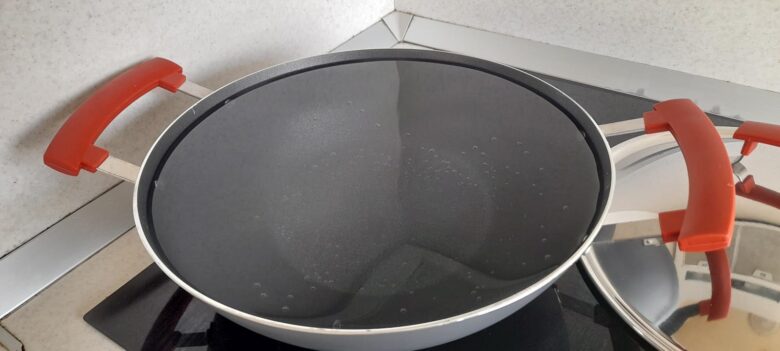
What Are the Handles Like?
The handles are pretty comfortable. I can get all four fingers around them, and they are ergonomic to hold. They’re also a little squishy if you press them firmly, easy to grip, and easy to clean.
Most importantly, though, the handles are designed not to transfer heat from the wok to your hands when cooking.
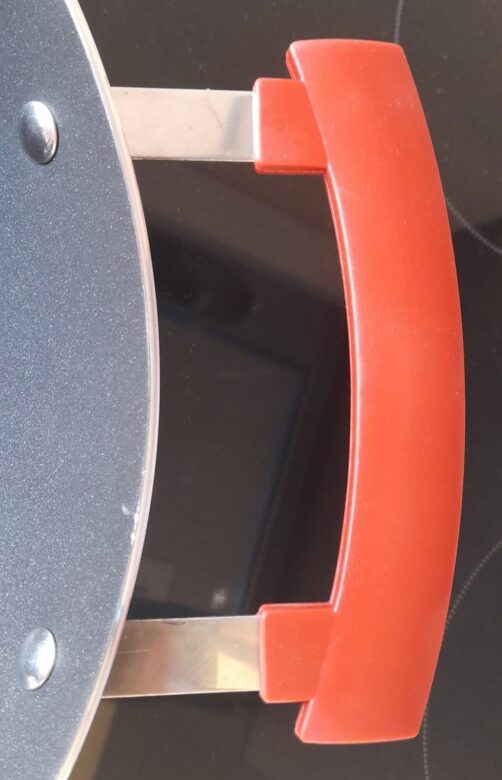
That said, they would melt if you applied them directly to heat (IKEA notes that this could happen when cooking on gas hobs).
The lid handle matches the design of the wok handles, but with minor differences—both are the same shade of red, made from the same material, and have a curve.
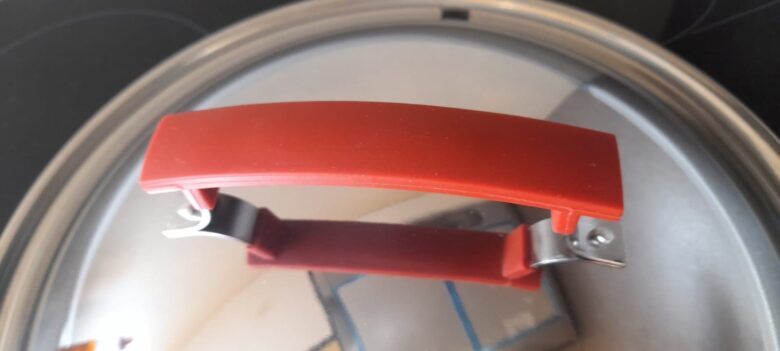
The wok and lid handles are also bolted in the same way. While they look secure, I do wonder how I would ever fix them if they broke.
Another thing worth mentioning is that the bolts are riveted. It would be better if they were rivetless because it would be easier to clean around them, but this is not such a major problem.
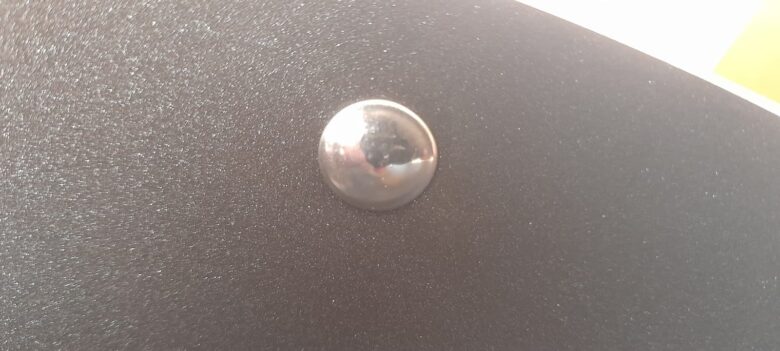
I struggled to find any information on what the handles were made of, though I have seen some suggestions online that they’re made of silicone.
What’s the Lid Like?
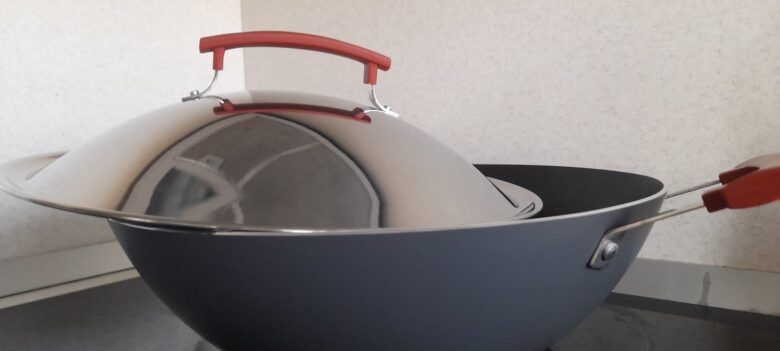
The lid is shiny and reflective and made from aluminum—not coated like the wok. The lid handle has almost the same design as the wok’s handles, but it is meant to be lifted from the top not held at the sides.
It has a practical design with a groove around the rim, so it sits nicely on top of the wok and won’t slide off when cooking.
You can also put the lid on upside-down so it’s inside the wok so it can be easily stored away without taking up too much space. The top handle doesn’t get in the way and fits inside.
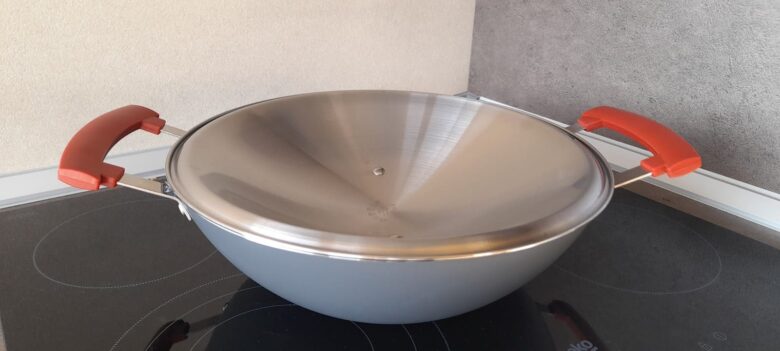
I do remember thinking; ‘after a few uses, will this lid be covered in watermarks?’ But a guess a nice bit of polishing would hide that.
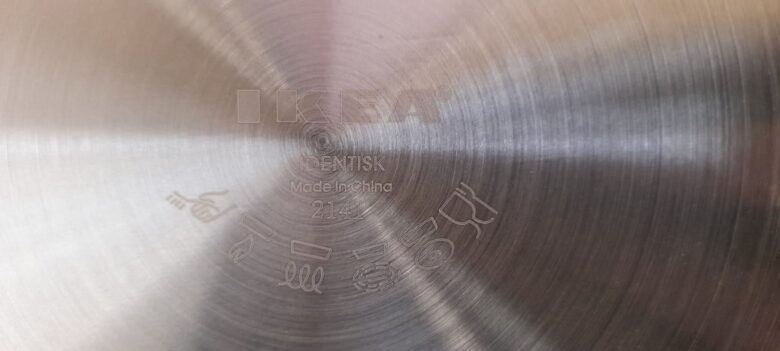
What’s the Base Like?
According to IKEA’s website, the base is “Aluminium, Stainless steel, Coated with Teflon(R) Select.” It’s not particularly thicker than the rest of the pan, though there is a small noticeable difference.
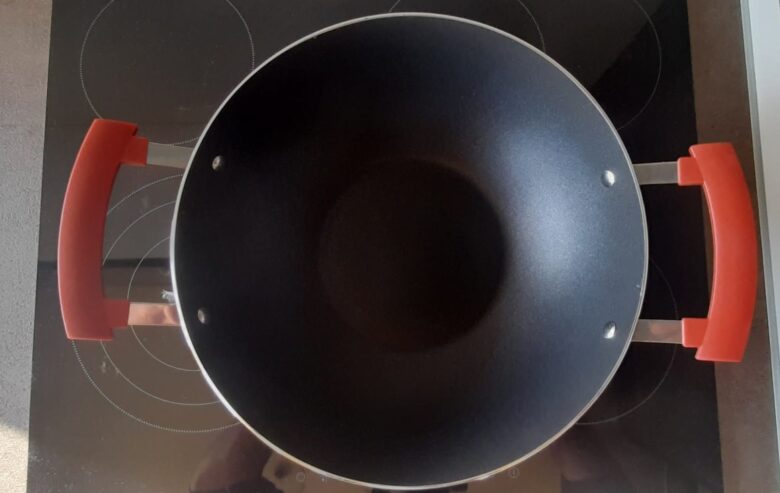
A modern design, the inside of the pan is a different shade of gray from the outside. This is down to the Teflon coating.
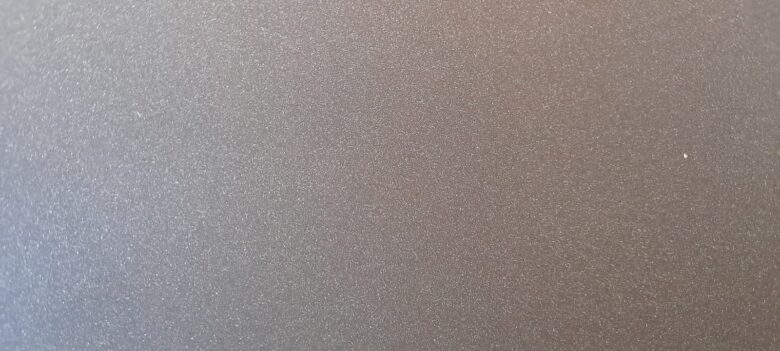
The non-stick (Teflon Select®) means that you won’t have to use so much oil or fat when cooking with this pan which is good. However, in the long run, don’t be surprised if it starts to accumulate scratches.
A flat bottom base supposedly means it’s easier to distribute heat. This is because there is more surface area in direct contact with the hob.
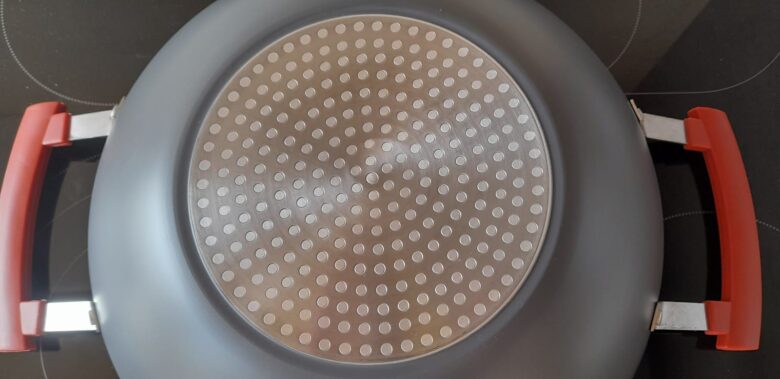
Flat bottom woks can also hold more food supposedly so you can make larger meals. This also means that you won’t need a wok ring to keep the wok in place.
Also worth noting is that the manual mentions that the base expands when hot.
Other Unique Features of the IDENTISK Wok
What I liked about the IDENTISK wok was how super lightweight and easy to move around it is. The first thing I noticed was that it was significantly lighter than it looks.
According to IKEA’s website, it weighs 1.51 kg (3.32 lbs.), but this must be with the lid because I weighed the wok alone at 1.1kg (2.42 lbs.).
The IDENTISK wok also includes a small vent to the side. You’d almost miss it if you weren’t looking for it. It’s a puny slit about half an inch long that sits in the groove that holds the lid on.
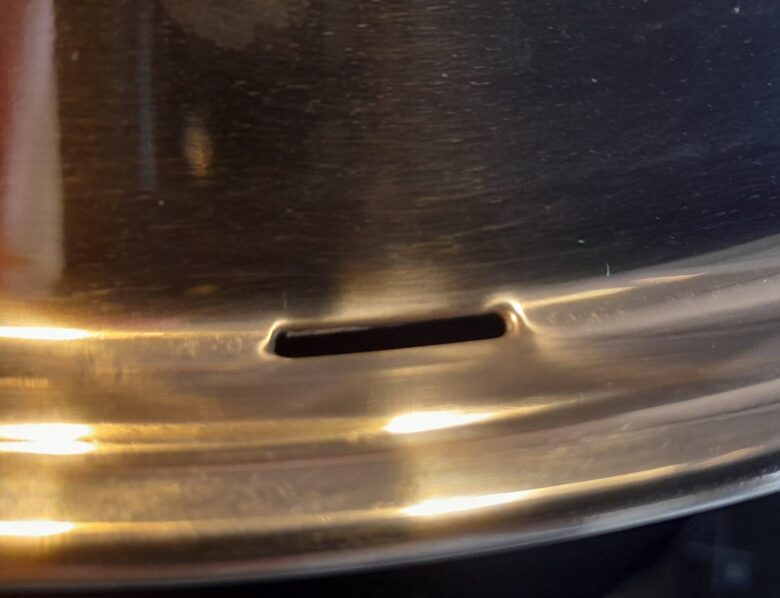
At first, I thought that I had bought a defective wok. As if this teeny hole was added by accident during production.
I know it’s just a vent, but it feels a bit lazy, but then again, maybe that’s genius of it—it’s a small hole to let out heat, how complex and fancy does it need to be?
How to Maintain and Clean the IDENTISK Wok
Check the instructions that come with the pan, they should be found inside. Covering only a page and a bit, there’s not too much to know, but some of it’s quite important for maintenance.
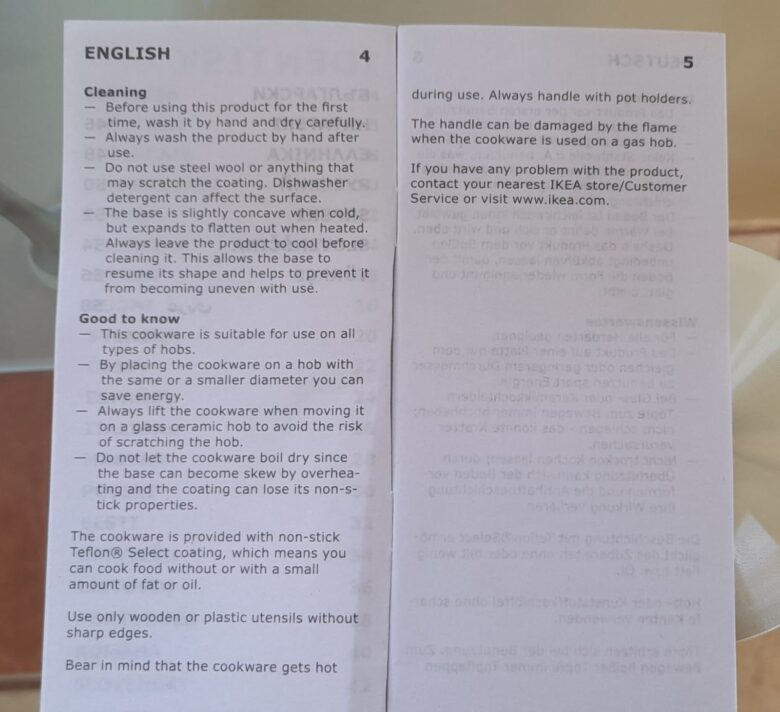
If you lose the instructions, you can check the online documentation from IKEA. I compared it against the documentation they provide with the wok and it’s the same.
You can also check Manuals+ which has a lot of useful information and tips on cleaning and maintaining the IDENTISK wok that’ll help with its longevity.
Some of the most useful things they advise include:
- Don’t put this wok in the dishwasher—only clean it by hand with a brush and do not use detergent.
- If you do clean the wok with detergent, oil the pan a little after.
- When using this wok for the first time, you can improve the pan by using slightly more cooking fat.
- This wok is not suitable for acidic foods.
Be careful moving the wok on a glass hob as it can damage the surface. The manual recommends lifting it when you want to move it.
Cooking with IKEA’s IDENTISK Wok
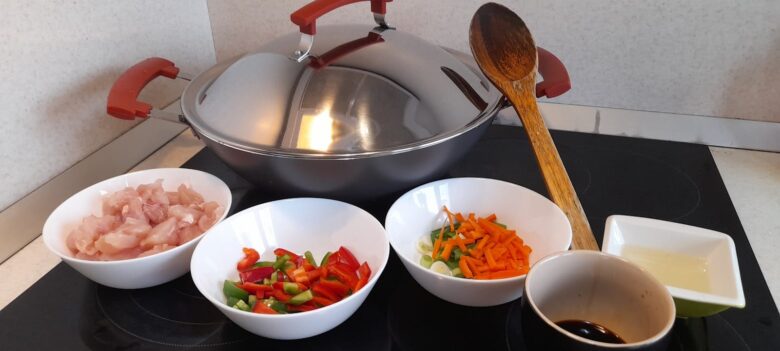
Cooking with the IDENTISK wok was pretty easy, but I’m not the most experienced with a wok, so I didn’t try anything too crazy—don’t expect me to start launching the food in the air.
As recommended, I rinsed it first (as you should do with any new cooking ware).
To test the wok, I decided to make chicken with rice noodles with green and red pepper, spring onion, carrot, and a bit of soy sauce (as seen above).
I used little more than two spoons of oil and was quite impressed by how the chicken didn’t stick to the pan.
I also used a hob that was roughly the same size as the base of the pan, and it heated at a decent pace.
Although IKEA recommends not moving the wok too much if cooking on a glass hob, I was impressed by how well it moved when I needed it to.
Granted, after a few uses where the bottom may get rougher, and if the contents of the pan were heavier, most likely it would scratch the surface.
The wok also rotates very well with the two handles making it easy to move around, hold still, and serve food when ready.
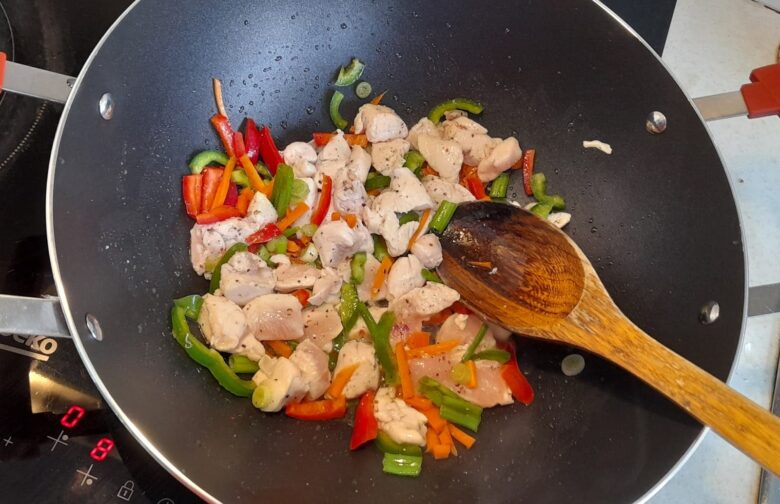
Another feature highlighted by IKEA is that “The heat is highest at the bottom, and the sloping sides make the food drop down.”—to be honest, this is a feature of most woks.
Remember, don’t use metal utensils to cook with this wok, it’ll damage the Teflon interior. Stick to wood or silicone or something similar. I also used a wooden spoon.
Things to Consider Before Buying IKEA’s IDENTISK Wok
The IDENTISK wok has a polytetrafluoroethylene (PTFE) coating, which is a little controversial. Whereas uncoated works are meant to be used over high heat, you shouldn’t cook anything in this wok over 500°F (260°C).
Overheating it can damage the coating and release toxic fumes into the air.
There’s also a growing movement away from PTFE-coated products because of perfluorooctanoic acid (PFOA), the man-made chemical once used in the manufacturing process.
Perfluorooctanoic acid is a disputed chemical that could have a negative effect on human health. According to an information sheet from the Minnesota Department of Health:
“[H]igher levels of PFOA in a person’s body were associated with higher cholesterol, changes to liver function, reduced immune response, thyroid disease, and increased kidney and testicular cancer.”
However, in IKEA’s description of the wok they do say, “No PFOA (perfluorooctanoic acid) is used to create the non-stick surface of this product.”
So, you can rest easy knowing that this wok is safe to use.
Elsewhere, IKEA promotes this wok by saying on their site, “A big advantage with aluminium is that it can be recycled again and again without losing its quality.”
But while aluminum is highly recyclable, PTFE isn’t. So, environmentally-minded persons might find this wok a bit of a turn-off.
That aside, there are still plenty of people who’d disregard this and are happy just to have a wok that doesn’t require them to deal with seasoning.
Next, the plastic packaging can get snagged in the joinings between the handle and the wok, so make sure you check it’s all removed before using it or you might get a repulsive melting plastic smell.
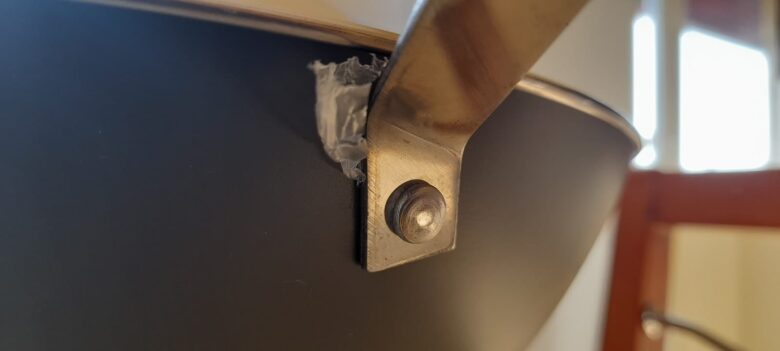
And lastly, I have seen a few images online of people absolutely wrecking this pan and I think this is from not caring for it properly, so make sure you read the instructions on cleaning and maintenance.
